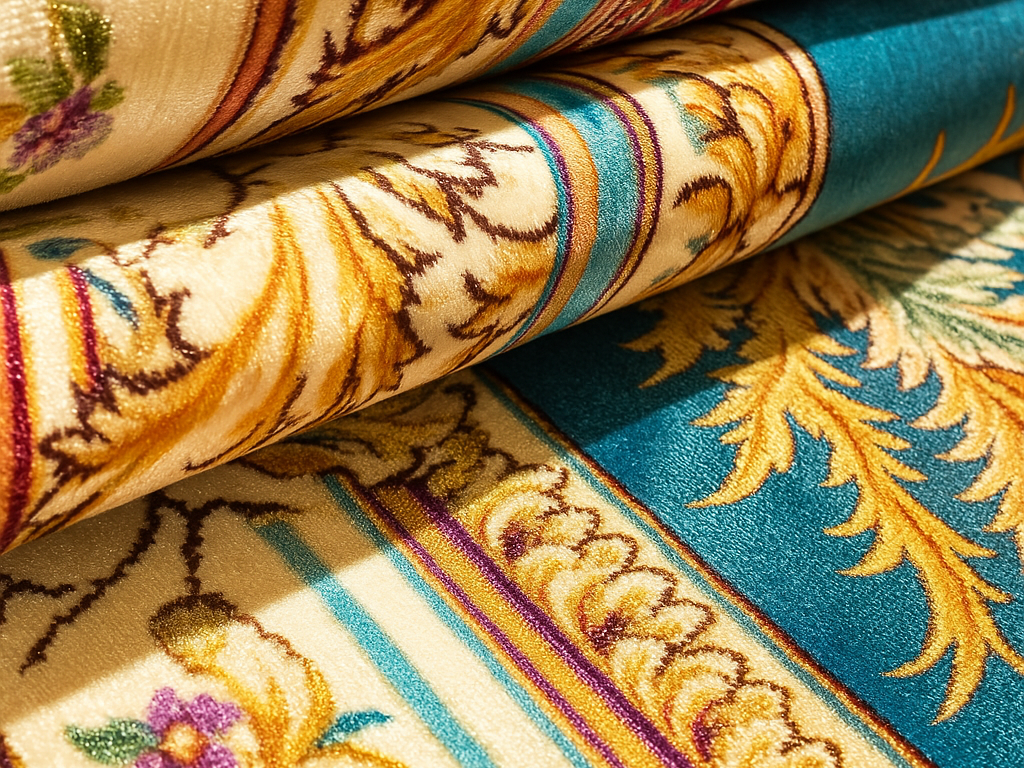Lorsque vous choisissez un tapis pour votre maison ou votre bureau, il est essentiel de comprendre les différences entre les tapis imprimés et les tapis tuftés. Chaque type de tapis offre des avantages et des considérations qui lui sont propres. Ce guide vous aidera à prendre une décision éclairée.
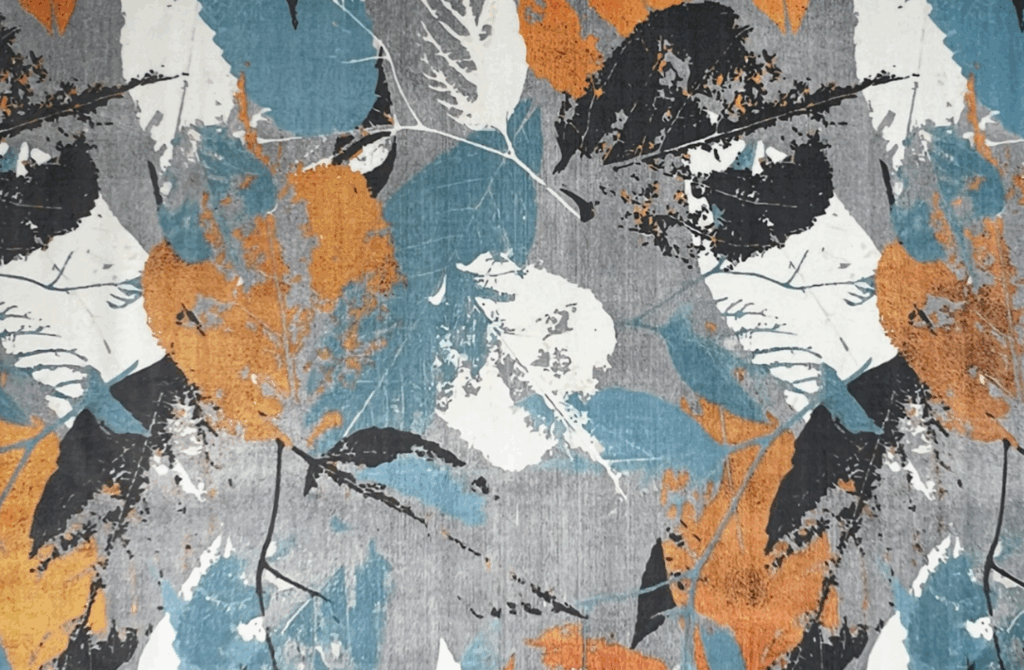
1. Comprendre les tapis imprimés
Tapis imprimés ont révolutionné l'industrie du revêtement de sol en offrant un mélange d'attrait esthétique, de prix abordable et de praticité. Contrairement aux tapis traditionnels qui s'appuient sur des techniques de tissage ou de nouage pour créer des motifs, les tapis imprimés utilisent des technologies d'impression avancées pour appliquer des motifs directement sur la surface du tapis. Cette méthode permet d'obtenir des motifs complexes en haute résolution qui peuvent imiter l'aspect de types de tapis plus coûteux.
Caractéristiques des tapis imprimés
- Diverses options de conception: Les tapis imprimés sont disponibles dans un large éventail de motifs, de couleurs et de styles, allant des motifs traditionnels aux dessins modernes et abstraits. Cette variété permet aux propriétaires et aux entreprises de choisir des modèles qui reflètent leur style personnel et complètent leur décor.
- Matériaux durables: Généralement fabriqués à partir de fibres synthétiques de haute qualité telles que Nylon ou en polypropylène, les tapis imprimés sont connus pour leur durabilité et leur résistance aux taches. Ces matériaux les rendent appropriés pour les zones à fort trafic telles que salonsles couloirs et les bureaux.
- Facile Maintenance: Les tapis imprimés sont conçus pour être faciles d'entretien. Un passage régulier de l'aspirateur et un nettoyage professionnel occasionnel suffisent généralement à préserver leur apparence, ce qui en fait un choix pratique pour les ménages occupés et les espaces commerciaux.
- Rentabilité: Comparés aux tapis noués ou fabriqués à la main, les tapis imprimés sont généralement plus abordables. Leur prix plus bas ne compromet ni le style ni la qualité, offrant un aspect haut de gamme sans l'étiquette de prix élevée.
- Installation facile: Les tapis imprimés sont faciles à installer et peuvent être coupés et façonnés pour s'adapter à des dimensions spécifiques, ce qui offre une grande souplesse dans l'agencement et la taille des pièces.
2. Explorer les tapis touffetés
Tapis tuftés sont créés en insérant des boucles de fil dans un matériau de support à l'aide d'un pistolet à touffeter. Ce processus forme un poil sur la surface, qui peut être coupé pour obtenir une texture pelucheuse ou laissé en boucles pour un toucher plus texturé. Les boucles sont fixées à l'aide d'un adhésif et un support secondaire est appliqué pour assurer la stabilité. Cette méthode permet de produire rapidement des tapis aux motifs complexes et aux textures variées.
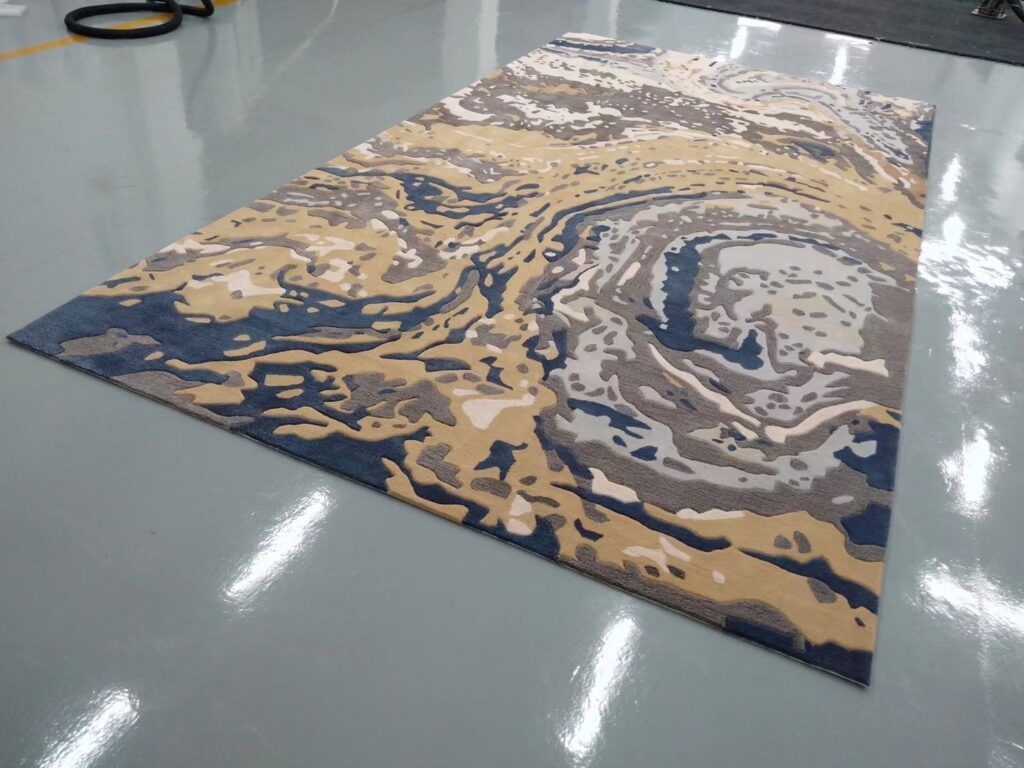
Caractéristiques des tapis touffus
- Polyvalence de la conception: Le procédé de touffetage permet d'obtenir une large gamme de motifs, de couleurs et de textures, s'adaptant ainsi à différents styles de décoration intérieure.
- Abordabilité: Comparés aux tapis noués à la main, les tapis tuftés sont généralement plus économiques tout en offrant un aspect artisanal.
- Confort: Les tapis touffetés sont souvent dotés d'un velours pelucheux, ce qui leur confère une surface douce et confortable sous les pieds.
- Production rapide: Le processus de tufting prend moins de temps que les méthodes traditionnelles de fabrication des tapis, ce qui permet des délais d'exécution plus courts.
3. Tapis imprimés et tapis tuftés
Lorsqu'il s'agit de choisir entre un tapis imprimé et un tapis tufté, il est essentiel de comprendre leurs caractéristiques distinctes afin de faire un choix éclairé qui corresponde à vos préférences esthétiques, à vos besoins fonctionnels et à votre budget. Voici une comparaison complète :
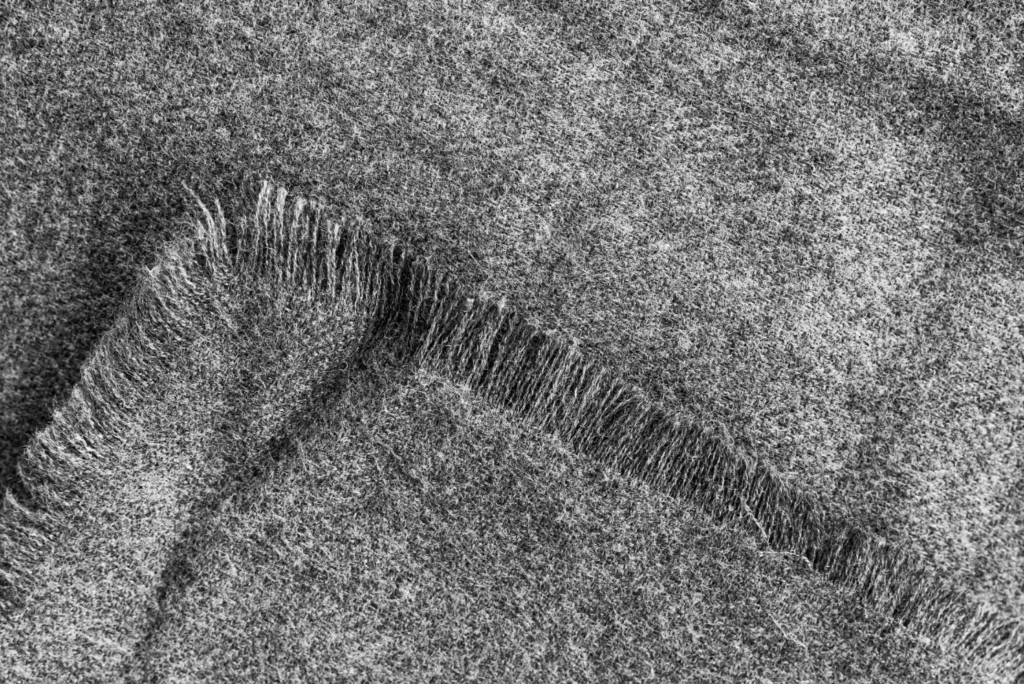
Construction et texture
- Tapis imprimés: Ces tapis présentent des motifs imprimés directement sur un tissu plat, ce qui permet d'obtenir une surface lisse et discrète. L'absence de poils les rend idéaux pour les zones où le passage des portes est un problème ou lorsqu'un aspect épuré est souhaité.
- Tapis tuftés: Créés en insérant du fil dans un support à l'aide d'un pistolet à touffeter, les tapis touffetés ont une surface moelleuse et texturée. Ils peuvent présenter des poils coupés ou bouclés, offrant une expérience tactile sous les pieds.
Conception et esthétique
- Tapis imprimés: Grâce à des techniques d'impression numérique avancées, ces tapis peuvent présenter des motifs complexes, des images photoréalistes et des couleurs éclatantes. Ils conviennent donc aux designs audacieux et contemporains ou aux marques personnalisées dans les espaces commerciaux.
- Tapis tuftés: Tout en offrant une large gamme de motifs, les tapis tuftés peuvent être limités dans la réalisation de motifs extrêmement détaillés par rapport aux tapis imprimés. Cependant, ils excellent dans l'apport de profondeur et de texture, mettant en valeur les intérieurs traditionnels et classiques.
Durabilité et longévité
- Tapis imprimés: Généralement fabriqués à partir de matériaux synthétiques, ils sont durables et résistants aux taches. Toutefois, les motifs imprimés peuvent s'estomper avec le temps, en particulier dans les zones très fréquentées.
- Tapis tuftés: En fonction des matériaux utilisés (laine, coton, matières synthétiques), les tapis tuftés peuvent être très durables. Les tapis tuftés à la main, en particulier, peuvent durer de nombreuses années s'ils sont bien entretenus, même s'ils peuvent perdre des plumes au début.
Coût et valeur
- Tapis imprimés: Généralement plus abordables en raison de l'efficacité du processus de production. Ils constituent une solution rentable pour ceux qui recherchent des designs élégants sans pour autant payer le prix fort.
- Tapis tuftés: Bien qu'ils soient généralement plus chers que les tapis imprimés, les tapis tuftés offrent un équilibre entre le coût et le savoir-faire. Les options tuftées à la main, en particulier celles fabriquées à partir de fibres naturelles, offrent une sensation de luxe à un prix modéré.
Maintenance et entretien
- Tapis imprimés: Leur surface plane les rend faciles à nettoyer. Il suffit souvent de passer l'aspirateur et de faire des petits nettoyages. Il convient toutefois de veiller à ce que le motif imprimé ne s'estompe pas.
- Tapis tuftés: Ces tapis peuvent nécessiter plus d'entretien, notamment un passage régulier de l'aspirateur pour gérer la mue et un nettoyage professionnel pour conserver leur aspect au fil du temps.
Scénarios d'utilisation idéale
- Tapis imprimés: Convient le mieux aux endroits où la flexibilité de la conception et le prix sont des priorités, tels que les chambres d'enfants, les aires de jeux ou les espaces commerciaux nécessitant une image de marque personnalisée.
- Tapis tuftés: Idéal pour les salons, les chambres à coucher et autres espaces où le confort et la sensation de peluche sont recherchés. Leur surface texturée ajoute de la chaleur et du confort à toutes les pièces.
Tableau de comparaison
| Fonctionnalité | Tapis imprimés | Tapis tuftés |
| Détail de la conception | Haute résolution et complexité | Moins détaillé, plus texturé |
| Texture | Lisse, plat | Doux, pelucheux |
| Durabilité | Modéré dans les zones à faible trafic | Bon avec un entretien adéquat |
| Maintenance | Facile à nettoyer | Nécessite un entretien régulier |
| Coût | Généralement plus faible | Modéré |
| Durée de vie | Plus court | Plus longtemps avec l'entretien |
4. Comment choisir entre un tapis imprimé et un tapis tufté ?
Pour choisir entre un tapis imprimé et un tapis tufté, il est essentiel de prendre en compte des facteurs tels que l'utilisation de la pièce, le budget, le confort et les préférences en matière de design. Voici un guide détaillé pour vous aider à prendre une décision en connaissance de cause :
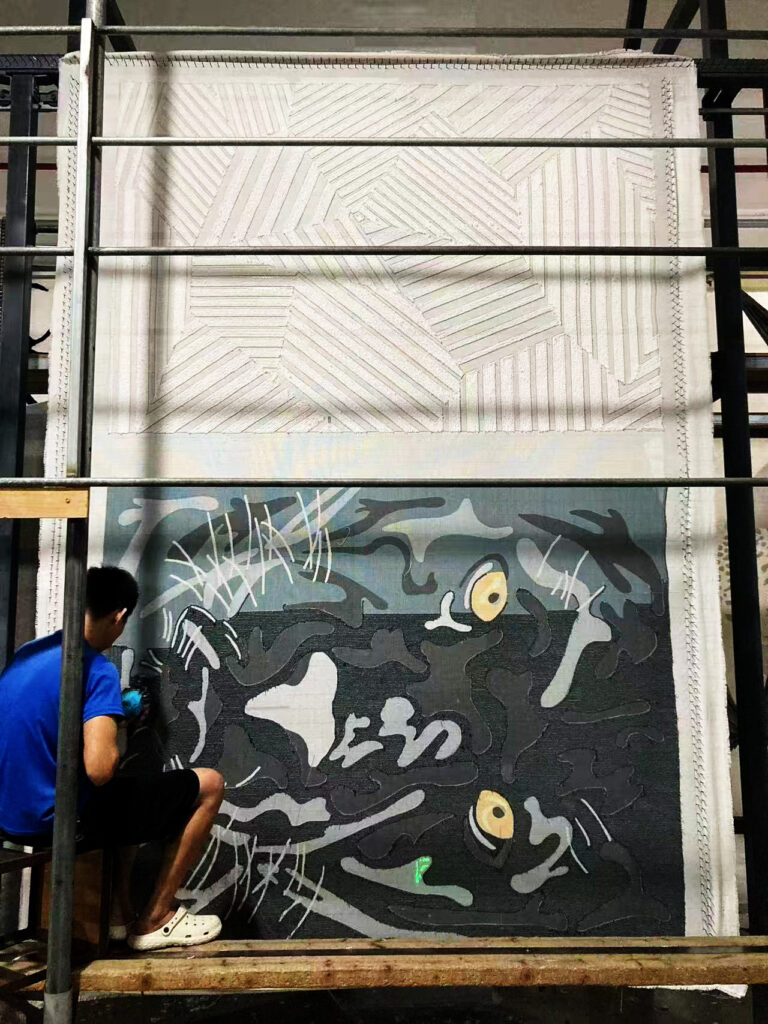
Utilisation des salles : Fonctionnalité et trafic
- Zones à fort trafic: Les tapis touffetés sont généralement plus durables et peuvent résister à un trafic piétonnier intense, ce qui les rend adaptés à des espaces tels que les salons, les couloirs et les entrées. Leur construction leur confère résilience et longévité dans les espaces très fréquentés.
- Espaces décoratifs ou à faible trafic: Les tapis imprimés offrent un large éventail d'options de conception et sont idéaux pour les zones peu fréquentées, telles que les chambres à coucher ou les bureaux à domicile. Ils peuvent ajouter un intérêt visuel sans avoir besoin d'une grande durabilité.
Budget : Rapport coût-efficacité et investissement
- Tapis imprimés: Généralement plus abordables en raison des techniques de production de masse. Ils constituent un choix rentable pour ceux qui cherchent à actualiser leur décor de manière saisonnière ou dans le cadre d'un budget limité.
- Tapis tuftés: Généralement plus chers, en raison de la qualité de l'artisanat et des matériaux utilisés. Cependant, ils offrent une meilleure longévité et une sensation plus luxueuse, ce qui en fait un investissement intéressant pour une utilisation à long terme.
Confort : Texture et sensation sous le pied
- Tapis tuftés: Connus pour leur douceur et leur moelleux sous les pieds, les tapis tuftés ajoutent de la chaleur et du confort à une pièce. Ils conviennent particulièrement aux espaces où le confort est une priorité, comme les chambres à coucher et les salons.
- Tapis imprimés: Ils ont souvent une texture plus plate et peuvent ne pas offrir le même niveau de confort que les tapis tuftés. Ils conviennent mieux aux endroits où la sensation de douceur sous les pieds est moins importante.
Préférence en matière de conception
- Motifs complexes: Les tapis imprimés offrent des motifs haute définition avec des lignes nettes et des motifs détaillés, y compris des images photoréalistes, grâce à des techniques d'impression avancées. Ils sont donc idéaux pour atteindre des objectifs esthétiques spécifiques.
- Motifs texturés: Si les tapis tuftés peuvent présenter des motifs complexes, ils peuvent aussi présenter de légères irrégularités dans les motifs répétitifs à petite échelle. Cependant, ils offrent une surface tactile et texturée qui ajoute de la profondeur à la décoration d'une pièce.
5. Conseils d'entretien pour les tapis imprimés et les tapis touffetés
Les tapis tuftés, souvent fabriqués en laine ou en coton, offrent un toucher moelleux et des motifs complexes. Leur l'entretien nécessite une attention particulière :
Aspiration régulière
- Passez l'aspirateur deux fois par semaine en utilisant un aspirateur à succion uniquement ou un aspirateur dont la barre de battage est éteinte afin d'éviter d'endommager les fibres.
- Évitez de passer l'aspirateur de manière agressive, car cela peut entraîner la formation de peluches ou la perte de poils.
Nettoyage ponctuel
- Épongez immédiatement les éclaboussures à l'aide d'un chiffon non teinté.
- Utilisez une solution détergente douce pour le nettoyage, en veillant à ce qu'elle soit adaptée à la matière du tapis.
- Évitez de tremper le tapis, car l'humidité excessive peut endommager le support adhésif.
Rotation régulière
- Tournez le tapis tous les 3 à 6 mois pour garantir une usure et une exposition au soleil uniformes.
Utiliser des tapis
- Les tapis peuvent empêcher les glissements et fournir un rembourrage supplémentaire.
- Ils contribuent également à réduire l'usure en absorbant l'impact du trafic piétonnier.
Nettoyage professionnel
- Demandez un nettoyage professionnel tous les 12 à 18 mois, en particulier pour les tapis en laine tuftée.
- Veillez à ce que le service de nettoyage ait l'expérience des tapis tuftés pour éviter de les endommager.
6. Conclusion
Le choix entre un tapis imprimé et un tapis tufté dépend de vos besoins spécifiques, de vos préférences et de l'utilisation prévue de l'espace. En comprenant les caractéristiques et les exigences d'entretien de chacun, vous pourrez sélectionner un tapis qui améliorera votre environnement tant sur le plan esthétique que fonctionnel.
7. FAQ
Q1 : Les tapis imprimés conviennent-ils aux zones très fréquentées ?
A1 : En raison de leur structure, les tapis imprimés conviennent mieux aux zones à trafic faible ou modéré.
Q2 : Les tapis tuftés perdent-ils des fibres ?
R2 : Oui, surtout lorsqu'il est neuf. Un passage régulier de l'aspirateur réduit la perte de poils au fil du temps.
Q3 : Puis-je utiliser un tapis tufté dans un environnement humide ?
A3 : Ce n'est pas recommandé, car l'humidité peut affecter le support adhésif.
Q4 : À quelle fréquence dois-je nettoyer mon tapis ?
A4 : Passez l'aspirateur toutes les semaines et envisagez un nettoyage professionnel tous les ans.
Q5 : Les tapis tuftés sont-ils plus chers que les tapis imprimés ?
A5 : En général, oui, en raison de leur construction et des matériaux utilisés.

